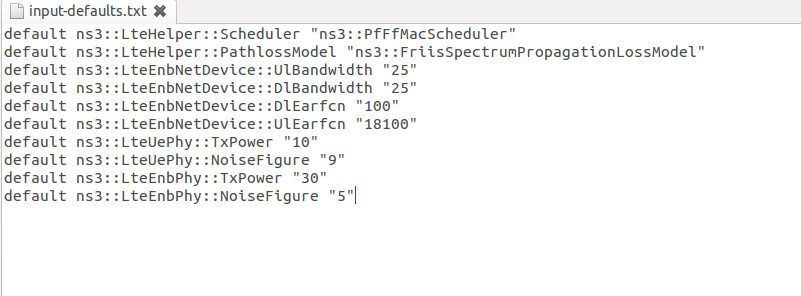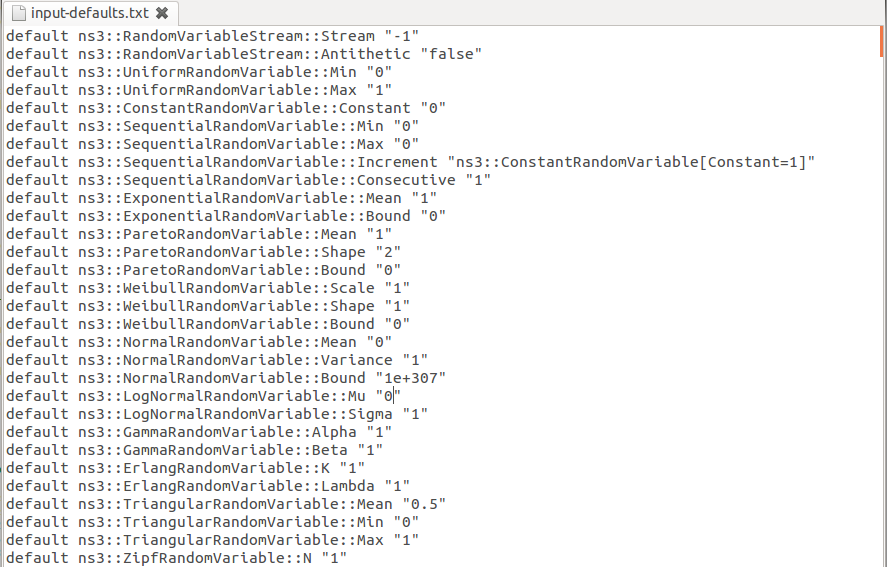LTE Module User Documentation(翻译1)——背景、使用概述、基本的仿真程序和配置LTE模型参数
LTE用户文档
2. 使用概述
- 定义仿真场景。
- 编写程序,重建期望的仿真场景拓扑/架构,通过使用 ns3::LteHelper API(定义在 src/lte/helper/lte-helper.h 中)访问 ns-3 LTE 模型库。
- 指定 objects 的配置参数,通过使用 input files(通过 ns3::ConfigStore)或直接在仿真程序中编写。
- 配置仿真器期望的输出。
- 运行仿真。
下面将通过实例解释这些步骤。
3. 基本的仿真程序
#include <ns3/core-module.h>
#include <ns3/network-module.h>
#include <ns3/mobility-module.h>
#include <ns3/lte-module.h> using namespace ns3; int main (int argc, char *argv[])
{
// the rest of the simulation program follows
Ptr<LteHelper> lteHelper = CreateObject<LteHelper> ();
NodeContainer enbNodes;
enbNodes.Create ();
NodeContainer ueNodes;
ueNodes.Create ();
注意上述节点实例此时并没有安装 LTE 协议栈;它们还是空节点。
MobilityHelper mobility;
mobility.SetMobilityModel ("ns3::ConstantPositionMobilityModel");
mobility.Install (enbNodes);
mobility.SetMobilityModel ("ns3::ConstantPositionMobilityModel");
mobility.Install (ueNodes);
上述代码会将所有节点放置在坐标 (0,0,0)。请参考 ns-3 移动性模型文档学习如何设置自己想要的位置或者配置节点运动。
NetDeviceContainer enbDevs;
enbDevs = lteHelper->InstallEnbDevice (enbNodes);
NetDeviceContainer ueDevs;
ueDevs = lteHelper->InstallUeDevice (ueNodes);
lteHelper->Attach (ueDevs, enbDevs.Get ());
enum EpsBearer::Qci q = EpsBearer::GBR_CONV_VOICE;
EpsBearer bearer (q);
lteHelper->ActivateDataRadioBearer (ueDevs, bearer);
Simulator::Stop (Seconds (0.005));
4 配置 LTE 模型参数
CommandLine cmd;
cmd.Parse (argc, argv);
ConfigStore inputConfig;
inputConfig.ConfigureDefaults ();
// parse again so you can override default values from the command line
cmd.Parse (argc, argv);
default ns3::LteHelper::Scheduler "ns3::PfFfMacScheduler"
default ns3::LteHelper::PathlossModel "ns3::FriisSpectrumPropagationLossModel"
default ns3::LteEnbNetDevice::UlBandwidth ""
default ns3::LteEnbNetDevice::DlBandwidth ""
default ns3::LteEnbNetDevice::DlEarfcn ""
default ns3::LteEnbNetDevice::UlEarfcn ""
default ns3::LteUePhy::TxPower ""
default ns3::LteUePhy::NoiseFigure ""
default ns3::LteEnbPhy::TxPower ""
default ns3::LteEnbPhy::NoiseFigure ""
./waf --command-template="%s --ns3::ConfigStore::Filename=input-defaults.txt --ns3::ConfigStore::Mode=Load --ns3::ConfigStore::FileFormat=RawText" --run src/lte/examples/lte-sim-with-input
./waf --command-template="%s --ns3::ConfigStore::Filename=input-defaults.txt --ns3::ConfigStore::Mode=Save --ns3::ConfigStore::FileFormat=RawText" --run src/lte/examples/lte-sim-with-input
.png)

#include "ns3/core-module.h"
#include "ns3/network-module.h"
#include "ns3/mobility-module.h"
#include "ns3/lte-module.h"
#include "ns3/config-store.h"
#include <ns3/buildings-helper.h>
//#include "ns3/gtk-config-store.h" using namespace ns3; int main (int argc, char *argv[])
{
CommandLine cmd;
cmd.Parse (argc, argv); //注意,先load 再 save!
// to save a template default attribute file run it like this:
// ./waf --command-template="%s --ns3::ConfigStore::Filename=input-defaults.txt --ns3::ConfigStore::Mode=Save --ns3::ConfigStore::FileFormat=RawText" --run src/lte/examples/lte-sim-with-input
//
// to load a previously created default attribute file
// ./waf --command-template="%s --ns3::ConfigStore::Filename=input-defaults.txt --ns3::ConfigStore::Mode=Load --ns3::ConfigStore::FileFormat=RawText" --run src/lte/examples/lte-sim-with-input ConfigStore inputConfig;
inputConfig.ConfigureDefaults (); // Parse again so you can override default values from the command line
cmd.Parse (argc, argv); Ptr<LteHelper> lteHelper = CreateObject<LteHelper> (); // Uncomment to enable logging
// lteHelper->EnableLogComponents (); // Create Nodes: eNodeB and UE
NodeContainer enbNodes;
NodeContainer ueNodes;
enbNodes.Create ();
ueNodes.Create (); // Install Mobility Model
MobilityHelper mobility;
mobility.SetMobilityModel ("ns3::ConstantPositionMobilityModel");
mobility.Install (enbNodes);
BuildingsHelper::Install (enbNodes);
// mobility.SetMobilityModel ("ns3::ConstantPositionMobilityModel");
// mobility.Install (ueNodes);
// BuildingsHelper::Install (ueNodes); mobility.SetPositionAllocator ("ns3::RandomDiscPositionAllocator",
"X", StringValue ("100.0"),
"Y", StringValue ("100.0"),
"Rho", StringValue ("ns3::UniformRandomVariable[Min=0|Max=30]"));
mobility.SetMobilityModel ("ns3::RandomWalk2dMobilityModel",
"Mode", StringValue ("Time"),
"Time", StringValue ("2s"),
"Speed", StringValue ("ns3::ConstantRandomVariable[Constant=1.0]"),
"Bounds", StringValue ("0|200|0|200"));
mobility.Install(ueNodes);
BuildingsHelper::Install (ueNodes); // Create Devices and install them in the Nodes (eNB and UE)
NetDeviceContainer enbDevs;
NetDeviceContainer ueDevs;
// Default scheduler is PF, uncomment to use RR
//lteHelper->SetSchedulerType ("ns3::RrFfMacScheduler"); enbDevs = lteHelper->InstallEnbDevice (enbNodes);
ueDevs = lteHelper->InstallUeDevice (ueNodes); // Attach a UE to a eNB
lteHelper->Attach (ueDevs, enbDevs.Get ()); // Activate a data radio bearer
enum EpsBearer::Qci q = EpsBearer::GBR_CONV_VOICE;
EpsBearer bearer (q);
lteHelper->ActivateDataRadioBearer (ueDevs, bearer);
//lteHelper->EnableTraces (); Simulator::Stop (Seconds (1.05)); // configure all the simulation scenario here...
lteHelper->EnablePhyTraces ();
lteHelper->EnableMacTraces ();
lteHelper->EnableRlcTraces ();
lteHelper->EnablePdcpTraces (); Simulator::Run (); // GtkConfigStore config;
// config.ConfigureAttributes (); Simulator::Destroy ();
return ;
}

.png)

.png)

.png)

.png)
参考文献
https://www.nsnam.org/docs/models/html/lte-user.html
LTE Module User Documentation(翻译1)——背景、使用概述、基本的仿真程序和配置LTE模型参数的更多相关文章
- LTE Module User Documentation(翻译15)——示例程序、参考场景以及故障检测和调试技巧
LTE用户文档 (如有不当的地方,欢迎指正!) 21 Examples Programs(示例程序) 路径 src/lte/examples/ 包含一些示例仿真程序,这些例子表明如何仿真不 ...
- LTE Module User Documentation(翻译13)——频率复用算法(Frequency Reuse Algorithms)
LTE用户文档 (如有不当的地方,欢迎指正!) 19 Frequency Reuse Algorithms(频率复用算法) 本节我们将描述如何在 LTE 仿真中使用频率复用(FR)算法.共有两 ...
- LTE Module User Documentation(翻译8)——核心网(EPC)
LTE用户文档 (如有不当的地方,欢迎指正!) 14 Evolved Packet Core (EPC) 我们现在讲解如何编写一个仿真程序——除了 LTE 无线接入网外,还允许仿真 EPC. EP ...
- LTE Module User Documentation(翻译5)——Mobility Model with Buildings
LTE用户文档 (如有不当的地方,欢迎指正!) 8 Mobility Model with Buildings 我们现在通过例子解释如何在 ns-3 仿真程序中使用 buildings 模型(特别 ...
- LTE Module User Documentation(翻译2)——配置LTE MAC 调度器
LTE用户文档 (如有不当的地方,欢迎指正!) 5 配置 LTE MAC 调度器 这里有几种 LTE MAC 调度器用户可以选择.使用下面的代码定义调度器的类型: Ptr<LteHelper ...
- LTE Module User Documentation(翻译14)——Uplink Power Control(上行功率控制)
LTE用户文档 (如有不当的地方,欢迎指正!) 20 Uplink Power Control(上行功率控制) 上行功率控制功能默认是开启的.用户可以通过设置布尔属性 ns3::LteUePhy: ...
- LTE Module User Documentation(翻译12)——X2切换(X2-based handover)
LTE用户文档 (如有不当的地方,欢迎指正!) 18 X2-based handover 正如 3GPP 定义的,切换是改变用户服务小区的连接方式的过程.这一过程中涉及的两个基站通常称为源基站和目 ...
- LTE Module User Documentation(翻译11)——配置用户测量
LTE用户文档 (如有不当的地方,欢迎指正!) 17 Configure UE measurements 仿真中激活的用户测量配置取决于所选的 “consumers”,例如切换算法.用户可能需要添 ...
- LTE Module User Documentation(翻译10)——网络连接(Network Attachment)
LTE用户文档 (如有不当的地方,欢迎指正!) 16 Network Attachment(网络连接) 正如前面章节 Basic simulation program 所述,连接用户到基站时通过调 ...
随机推荐
- 内存映射MMAP和DMA【转】
转自:http://blog.csdn.net/zhoudengqing/article/details/41654293 版权声明:本文为博主原创文章,未经博主允许不得转载. 这一章介绍Linux内 ...
- spin_lock、spin_lock_irq、spin_lock_irqsave区别【转】
转自:http://blog.csdn.net/luckywang1103/article/details/42083613 void spin_lock(spinlock_t *lock); voi ...
- netstat -aon|findstr 8888 终止进程
netstat -aon|findstr 8888 # 根据端口号查找进程C:\Users\Administrator>netstat -ano | findstr TCP LISTENING ...
- js词法作用域规则
function foo() {console.log( a ); // 2不是3} function bar() {var a = 3;foo();} var a = 2;bar(); js中的作用 ...
- recycleview中使用checkbox导致的重复选中问题
参考博文:http://www.myexception.cn/mobile/1852852.html 在使用RecycleView做仿微信图片选择器,其中条目中使用了checkbox,在选中时由于ho ...
- 【转】JS 和 java 交互
android中如何获得webView中的内容发表于 2011 年 06 月 13 日 由 admin本文概要:在程序中经常会用到webView来显示网页,但如果能够得到网页中的内容呢,本文将给你一个 ...
- 【图像处理】ISP 图像传感器camera原理
1.Color Filter Array — CFA 随着数码相机.手机的普及,CCD/CMOS 图像传感器近年来得到广泛的关注和应用. 图像传感器一般都采用一定的模式来采集图像数据,常用的有 BGR ...
- Oracle 客户端安装配置
电脑上安装了Oracle11G,我远程导出一个10g的数据库数据时,报了错误,猜测可能是我的11G客户端版本的问题.所以下载了10G的客户端 安装. 其实客户端的配置读取的是两个文件监听配置文件lis ...
- UML的概念模型
为 了理解UML,需要形成该语言的概念模型,这要求学习建模的3个要素:UML的基本构造块.支配这些构造块如何放在一起的规则和一些运用于整个UML的公 共机制.如果掌握了这些思想,就能够读懂UML模型, ...
- c++中两种常量方法的比较
[c++]在C++中定义常量的两种方法的比较 常量是定以后,在程序运行中不能被改变的标识符.C++中定义常量可以用#define .const 这两种方法.例如: #define PRICE 10 ...
